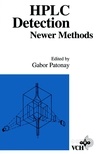HPLC Detection: Newer Methods
![]()
Book Description:
HPLC Detection Newer Methods Edited by Gabor Patonay This book provides a detailed survey of the more powerful and less conventional HPLC detection methods available today. Addressing both theory and application, experts give their assessment of some of the most promising detection methods being developed. Long lived luminescence, near-infrared semiconductor laser fluorescence, and HPLC-mass spectrometry are among the methods discussed. In addition, an entire chapter is devoted to showing how the ultimate power of NMR may be combined with HPLC. This book serves the needs of chromatographers who find their work restricted by the limits of conventional HPLC detection methods, and whose practical needs dictate the use of newer, more powerful methods.
Table of Contents:
1. Measurement Concepts and Laser-Based Detection in High-Performance Micro Separations
T. J. Edkins and D. C. Shelly
1.1. Purpose
1.2. Introduction
1.2.1. The Instrument Response Function and Figures of Merit
1.2.2.Concentration and Mass Sensitivity
1.2.3.Optical Imaging and Detection Strategies
1.2.4. Direct and Indirect Detection
1.2.5. Varieties of Micro Separations
1.3. Laser-Based High-Performance Micro Separation Measurements
1.3.1. Review of Trends
1.3.2. Approaches to Selective Detection Using Lasers
1.3.3. Approaches to Universal Detection Using Lasers
1.4. Summary and Future Developments
1.5. Acknowledgments
1.6. References
2. Long-Lived Luminescence Detection in Liquid Chromatography
C. Gooijer, M. Schreurs, and N.H. Velthorst
2.1. Introduction
2.2 Room-Temperature Phosphorescence in Liquids
2.2.1. Sensitized Phosphorescence Detection
2.2.2. Quenched Phosphorescence Detection
2.3. Lanthanide Luminescence in Liquids
2.3.1. Spectroscopy of Lanthanides
2.3.2. The Potential of Lanthanide Luminescence Detection
2.3.3. Sensitized Lanthanide Luminescence Detection/Underivatized Analytes
2.3.4.Sensitized Lanthanide
2.3.5.Detection Based on Quenched Lanthanide Luminescence
2.4. Concluding Remarks
2.5. References
3. Chemiluminescent Detection in High-Performance Liquid Chromatography
D. S. Hage
3.1. Introduction
3.2. Principles of Chemiluminescence
3.3. Systems for Chemiluminescent Detection in HPLC
3.4. Chemiluminescent Reactions and Applications
3.4.1. Bioluminescence
3.4.2. Peroxyoxalate System
3.4.3. Luminol
3.4.4. Lucigenin
3.4.5. Acridinium Ester
3.4.6. Other Chemiluminescent Systems
3.5. Conclusion
3.6. References
4. HPLC Detection in the Near Infrared
G. Patonay and T. Czuppon
4.1. Introduction
4.2. Fluorescence Properties of
NIR Absorbing Chromopbores
4.3. Laser Diodes
4.3.1. Intracavity Applications
4.4. Near-Infrared Fluorophore Labels
4.5. Conclusion
4.6. Acknowledgment
4.7. References
5. Electrochemical Detection for Liquid Chromatography
J. Wang
5.1. Introduction
5.1.1. Principles
5.1.2. Theory
5.2. Mobile Phase Requirements
5.3. Electrodes
5.4. Cell Design
5.5. Detection Modes
5.5.1. Pulsed Amperometric Detection
5.5.2. Potential Scanning
5.5.3. Multiple-Electrode Detection
5.5.4. Differential Pulse Amperometry
5.5.5. Tensammetric Detection
5.5.6. Improved Detection via Derivatization
5.5.7. Conductivity and Potentiometric Detections
5.6. Applications
5.7. Conclusions
5.8. References
6. Photothermal Detectors for High-Performance Liquid Chromatography
C. D. Tran
6.1. Introduction
6.2. Theory
6.3. Instrumentation
6.3.1. Thermal Lens Spectrometry
6.3.2. Photothermal Deflection Spectrometry
6.4. Applications
6.5. Other Applications
6.6. Future Prospects
6.7. Acknowledgment
6.8. References
7. HPLC Detection Using Fourier Transform Infrared Spectrometry
V. F. Kalasinsky and K. S. Kalasinsky
7.1. Introduction
7.1.1. Background
7.1.2. FT-IR Spectrometry
7.1.3. Design Considerations for HPLC/FT-IR
7.2. Flow-Cell Techniques for HPLC/FT-IR
7.2.1. Analytical-Column HPLC
7.2.2. Microbore-Column HPLC
7.3. Solvent-Elimination Techniques for HPLC/FT-IR
7.3.1. Analytical-Column HPLC
7.3.2. Microbore-Column HPLC
7.4. Related Chromatography-Infrared Interfaces
7.4.1. Supercritical Fluid Chromatography
7.4.2. Thin-Layer Chromatography
7.4.3. Near-IR HPLC
7.5. The Current Status of HPLC/FT-IR
7.6. References
8. HPLC Detection by Mass Spectrometry
K. B. Tomer
8.1. Introduction
8.2. Interface Designs
8.2.1.Transport Interfaces
8.2.2.Direct Liquid Introduction
8.2.3.Thermospray
8.2.4.Particle Beam
8.2.5.Continuous-Flow Fast Atom Bombardment
8.2.6.Electrospray/Ion Spray
8.3. Applications
8.3.1.Drugs and Drug Metabolites
8.3.2.Herbicides, Pesticides, and Their Metabolites
8.3.3.Natural Products
8.3.4.Environmental Samples
8.3.5.Peptides and Proteins
8.3.6.Nucleobases, Nucleosides, and Nucleotides
8.3.7.Saccharides
8.3.8.Lipids
8.3.9.Phospholipids
8.3.10. Steroids
8.4. Conclusion
8.5. References
9. High-Performance Liquid Chromatography Proton Nuclear Magnetic Resonance On-Line Coupling
K. Albert and E. Bayer
9.1. Introduction
9.2. Effect of Flow on the NMR Signal
9.3. Development of Continuous-Flow NMR Probes
9.3.1. Determination of Detector Dispersion Effects
9.3.2. Iron Magnet Systems
9.3.3. Cryomagnet Systems
9.4. Experimental Arrangement for HPLC-NMR Using Cryomagnets
9.5. Applications in Absorption Chromatography
9.5.1. Substituted Aromatics
9.5.2. Hydrocarbons
9.6. Applications in Reversed Phase Chromatography
9.6.1. Separation of Acetonitrile
9.6.2. Techniques of Solvent Signal Suppression in Flowing Liquids
9.7. Stopped-Flow Technique
9.7.1. Cyclopropyl-Containing Drug
9.7.2. Polyester
9.8. Further Developments in HPLC-NMR Coupling
9.9. References
Index

